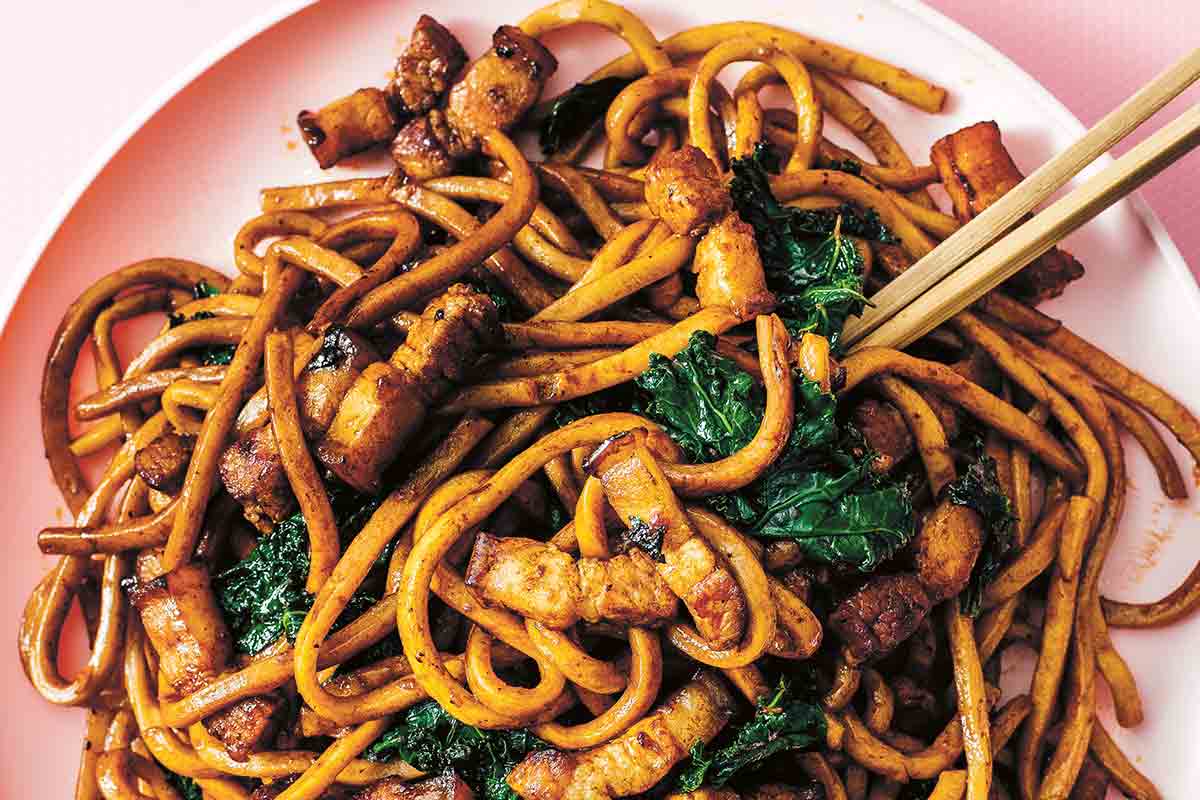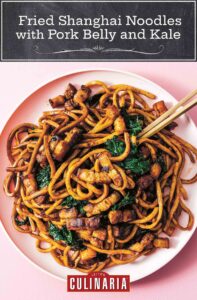This calming bowl of bubble gum Fried Shanghai Noodles with crispy pork belly and kale is on the table in just 20 minutes. No wok required.
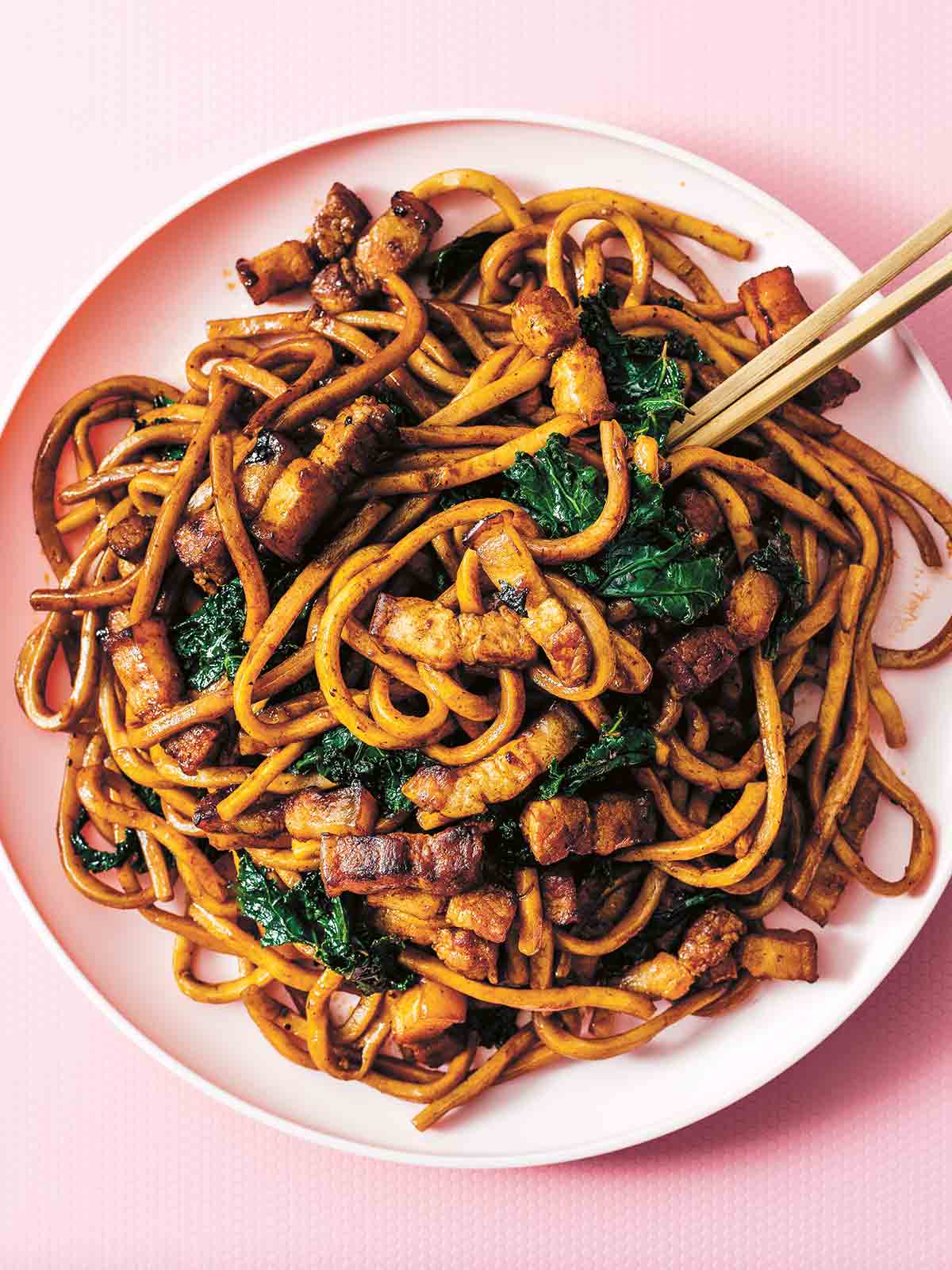
Adapted by Mike and Stephanie Le | The Noodle Life | Workman Publishing, 2022
Why order when you can fry your own plate of pasta in 20 minutes or less? There are a few ways to ensure a quality plate: A quick marinade of cornstarch and Shaoxing wine for the pork will help tenderize it and enhance browning; a mixture of dark and light soy sauce adds color and saltiness; and searing the noodles over high heat adds a wok smokiness, even if you don’t have a wok.
You can find Shanghai noodles in the fresh noodles section of your local Asian grocery store, or grab a packet of frozen udon (both are pre-cooked).—Mike Le and Stephanie Le
Why our testers loved this
There’s a whole host of reasons why our recipe testers happily slurped up these noodles. They loved like fast and easy it was to prepare the dish, and for this only a was required handful of ingredientsI’ll do it perfect for a weeknight meal.
Rema S. summed it up best with her comment: “Who doesn’t love a bowl full squishy, sassy, chewy noodles?“
Notes on ingredients
- Shaoxing wine– This is also known as Chinese rice wine. It is available in Asian markets and many supermarkets. If it’s not available to you, substitute dry sherry.
- pork belly–These crispy pork morsels add flavor and richness to the noodles. Don’t be tempted to remove the fat from the pork belly. When fried quickly, it becomes wonderfully crispy.
- Shanghai noodles–These fresh wheat noodles are available in the refrigerated section of Asian markets and large supermarkets. You can also substitute frozen udon noodles.
- neutral oil– Your wok or pan will be very hot, so be sure to use an oil with a high smoke point such as canola or peanut oil.
- Kale– The bold texture of kale holds up well in the high heat of the pan, but you could substitute another bold green like kale or an Asian vegetable like gai lan.
How to make this recipe
- Spread pork. In a large bowl, mix together 1 tablespoon light soy sauce, cornstarch, Shaoxing wine, and sugar. Add the pork belly and mix until the pork is completely coated.
- Make the sauce. In a small bowl, combine 1 tablespoon light soy sauce with the dark soy sauce, hoisin, chicken broth, and sesame oil.
- Soak noodles. Fill a large bowl with hot water and add the noodles. Soak until warmed through, then drain.
- cook pork. Heat a wok or skillet until smoking, then stir in the oil. Add the pork and cook until golden and crispy.
- Fry the noodles. Stir in the kale and cook until it begins to wilt. Add pasta and sauce and sauté over high heat until lightly charred.
- Surcharge. Garnish with spring onions, roasted onions and chili oil, if you like.
Frequently asked questions about recipes
What is the difference between light and dark soy sauce?
Dark soy sauce is sweeter, thicker, and has a stronger flavor than light soy sauce. The dark soy sauce also gives the noodles their dark color. They differ significantly and should not be interchanged.
Can I use other meats or vegetables in the Shanghai noodles?
Absolutely. This Shanghai noodle recipe offers a simple version of stir-fried noodles, but feel free to swap in shrimp or chicken, or try an Asian vegetable like gai lan (Chinese broccoli) in place of the kale.
What are Shanghai noodles?
These popular Asian noodles are made from wheat and are slightly thicker than spaghetti with a slightly chewy texture. They are usually stir-fried with vegetables, meat, poultry or shrimp and an Asian sauce.
Helpful tips
- This recipe results in a pasta dish that is lightly coated in sauce. If you prefer more acidic pasta, double the sauce.
- If your noodles start to clump or stick together after soaking, give them a quick rinse in cold water before setting aside.
- Leftover pasta can be stored in a sealed container for up to 3 days. To reheat, heat in a skillet over medium-high heat until warmed through, adding water or chicken broth as needed to fluff the noodles.
More great Asian noodle recipes
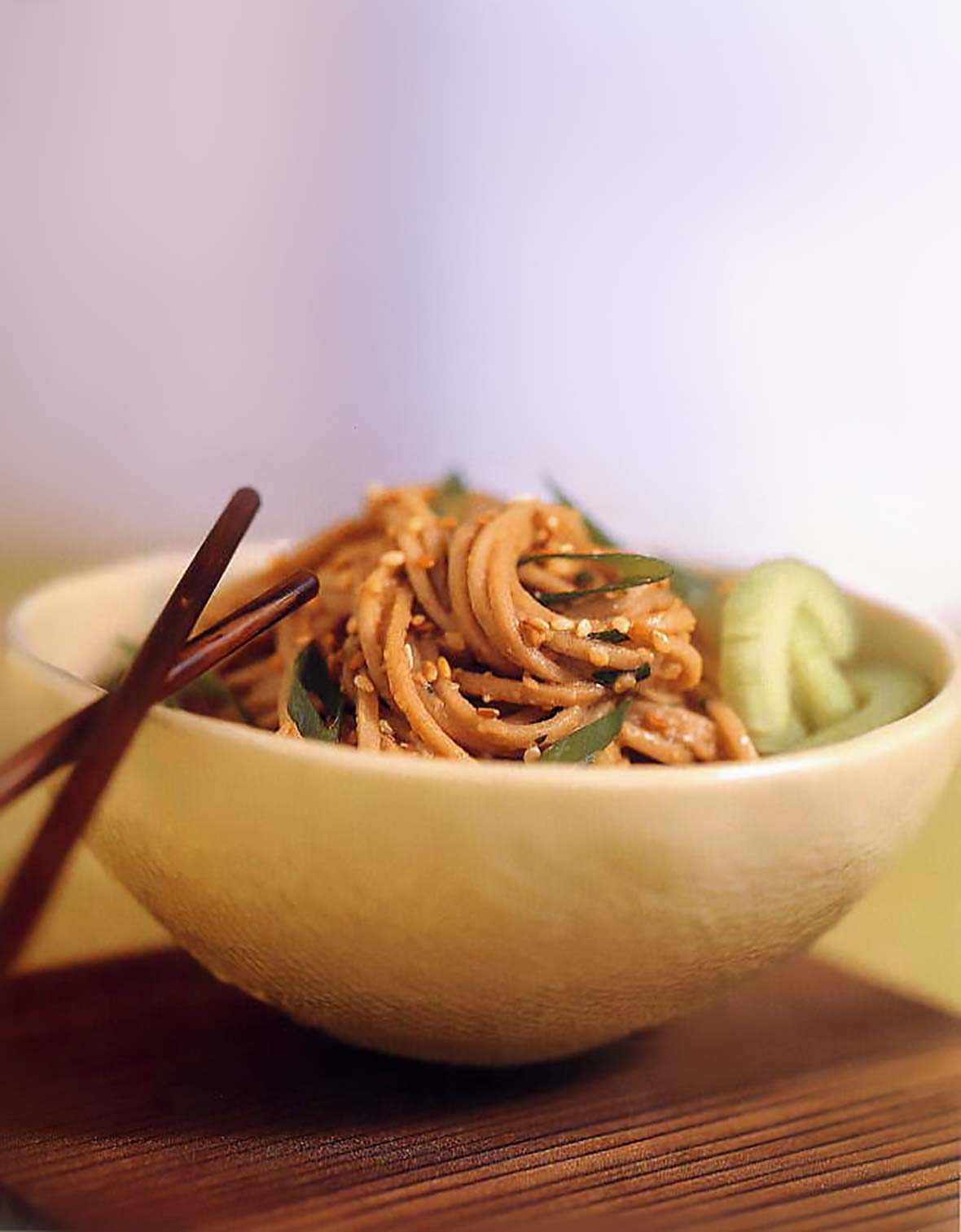
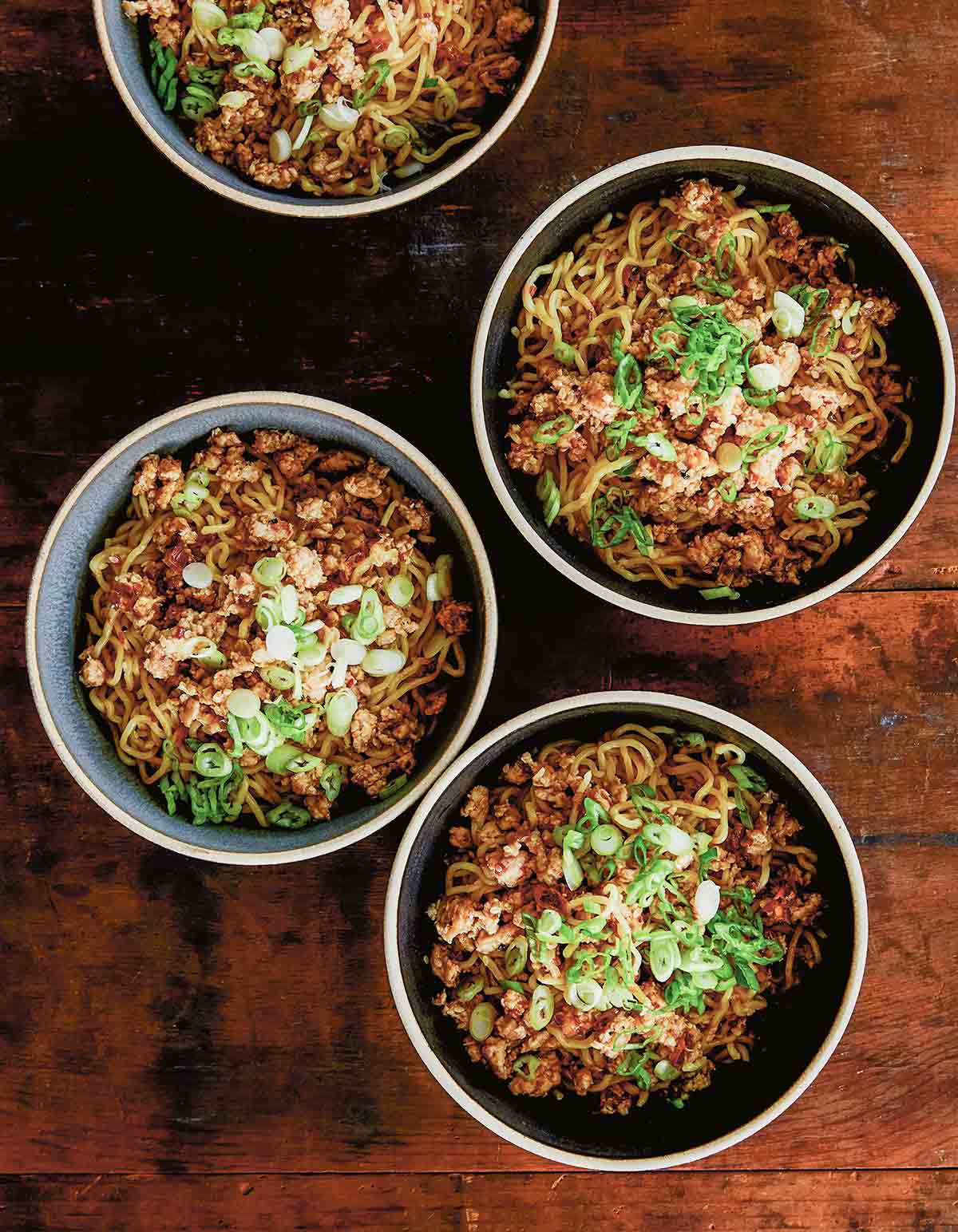
☞ If you prepare this recipe or any other dish on LC, consider leaving a reviewa Rating in starsand your best photo in the comments below. I love hearing from you.–David
Fried Shanghai Noodles
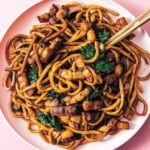
Chewy Shanghai noodles mix with crispy pork belly and kale in an addictive soy hoisin sauce for this quick and easy weeknight dinner.
-
In a large bowl, mix together 1 tablespoon of the light soy sauce, cornstarch, Shaoxing wine, and sugar. Add the pork and mix until the pork is completely coated.
-
In a small bowl, combine the remaining 1 tablespoon light soy sauce with the dark soy sauce, hoisin sauce, chicken broth, and sesame oil.
-
Fill a large bowl with hot tap water and add the noodles. Soak for 30 seconds to 1 minute until loosened and warmed through. Drain and set aside. (If using frozen udon, soak for 2 to 3 minutes until thawed.)
-
Heat a large wok or skillet over medium-high heat. When the wok begins to smoke, add the oil and toss until shimmering. Add the pork with its marinade and cook, stirring occasionally, until golden and crispy, 3 to 5 minutes.
-
Add the kale and toss to combine. When the kale has wilted slightly, add the noodles and sauce. Turn up the heat and toss to combine. Sauté until smoky and lightly charred, about 2 minutes.
-
If desired, serve hot with chopped spring onions, crispy roasted onions and/or chili oil.
- Double the sauce –This recipe results in a pasta dish that is lightly coated in sauce. If you prefer more acidic pasta, double the sauce.
- Sticky Noodles–If your noodles start to clump or stick together after soaking, give them a quick rinse in cold water before setting aside.
- Storage and Rewarming–Leftover pasta can be stored in a sealed container for up to 3 days. To reheat, heat in a skillet over medium-high heat until warmed through, adding water or chicken broth as needed to fluff the noodles.
Portion: 1portionCalories: 546kcal (27%)Carbohydrates: 38G (13%)Protein: fifteenG (30%)Fat: 38G (58%)Saturated Fatty Acids: 12G (75%)Polyunsaturated fat: 5GMonounsaturated fatty acids: 17GTrans fats: 0.01GCholesterol: 41mg (14%)Sodium: 1234mg (54%)Potassium: 322mg (9%)Fiber: 5G (21%)Sugar: 7G (8th%)Vitamin A: 4962ie (99%)Vitamin C: 47mg (57%)Calcium: 134mg (13%)Iron: 1mg (6%)
![]() If you make this recipe, take a picture and tag it with a hashtag #LeitesCulinaria. We would love to see your creations on Instagram, Facebook and others Twitter.
If you make this recipe, take a picture and tag it with a hashtag #LeitesCulinaria. We would love to see your creations on Instagram, Facebook and others Twitter.
Recipe tester reviews

